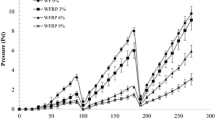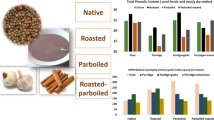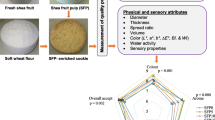Abstract
The total phenolics and flavonoids, rutin, early, advanced and final Maillard reaction products, and antioxidative capacity determined against 2,2′-azinobis-(3-ethylbenzothiazoline-6-sulfonate) radical cation and superoxide anion radicals were used for the characterization of the quality of novel rye-buckwheat ginger cakes enriched with rutin (quercetin rutinoside). The cakes were prepared substituting 30 % of rye flour by light buckwheat flour or flour from roasted buckwheat dehulled grains and employing a dough fermentation-like incubation step. Enrichment of ginger cakes with rutin showed protective effect on lysine blockage, improved antioxidant properties, inhibited the formation of furosine and free fluorescent compounds thus stimulating the Maillard reaction progress towards melanoidin formation. The loss of the nutritional quality of cakes enriched with rutin was related to the formation of fluorescent compounds linked to protein and carboxymethyllysine at an advanced stage of the Maillard reaction. It can be concluded that free fluorescence intermediatory compounds, carboxymethyllysine and browning are the best chemical markers for the characterization of the quality of this novel type of ginger cakes. This study also indicates that rye-buckwheat ginger cakes enriched with rutin can be recommended for wider consumption since daily consumption of 250 g of these cakes may have a prophylactic or therapeutic effect corresponding to typical pharmacological drugs with rutin as the active component.
Similar content being viewed by others
References
Alamprese, C., Casiraghi, E., & Pagani, M. A. (2007). Development of gluten-free fresh egg pasta analogues containing buckwheat. European Food Research and Technology, 225, 205–213. DOI: 10.1007/s00217-006-0405-y.
Alvarez-Jubete, L., Wijngaard, H., Arendt, E. K., & Gallagher, E. (2010). Polyphenol composition and in vitro antioxidant activity of amaranth, quinoa buckwheat and wheat as affected by sprouting and baking. Food Chemistry, 119, 770–778. DOI: 10.1016/j.foodchem.2009.07.032.
American Association of Cereal Chemists (2000). Approved methods of the American association of cereal chemists (10th ed.). St. Paul, MN, USA: American Association of Cereal Chemists.
Association of Official Agricultural Chemists International (1990). Official methods of analysis of AOAC international (15th ed.). Washington, DC, USA: Association of Official Agricultural Chemists International.
Baljeet, S. Y., Ritika, B. Y., & Roshan, L. Y. (2010). Studies on functional properties and incorporation of buckwheat flour for biscuit making. International Food Research Journal, 17, 1067–1076.
Bojnanská, T., Francáková, H., Chlebo, P., & Vollmannová, A. (2009). Rutin content in buckwheat enriched bread and influence of its consumption on plasma total antioxidant status. Czech Journal of Food Science, 27, S236–S240.
Bosch, L., Sanz, M. L., Montilla, A., Alegría, A., Farré, R., & del Castillo, M. D. (2007). Simultaneous analysis of lysine, Ne-carboxymethyllysine and lysinoalanine from proteins. Journal of Chromatography B, 860, 69–77. DOI: 10.1016/j.jchromb.2007.10.011.
Burluc, R. M., Vizireanu, C., Dinica, R., & Dima, F. (2012). The use of pseudo-cereals flours in bakery. Scientific Study & Research: Chemistry & Chemical Engineering, Biotechnology, Food Industry, 13, 177–186.
Capuano, E., Ferrigno, A., Acampa, I., Serpen, A., Açar, Ö. Ç., Gökmen, V., & Fogliano, V. (2009). Effect of flour type on Maillard reaction and acrylamide formation during toasting of bread crisp model systems and mitigation strategies. Food Research International, 42, 1295–1302. DOI: 10.1016/j.foodres.2009.03.018.
Chua, L. S. (2013). A review on plant-based rutin extraction methods and its pharmacological activities. Journal of Ethnopharmacology, 150, 805–817. DOI: 10.1016/j.jep.2013. 10.036.
Ciesarová, Z., Kukurová, K., Bednáriková, A., & Morales, F. J. (2009). Effect of heat treatment and dough formulation on the formation of Maillard reaction products in fine bakery products–benefits and weak points. Journal of Food and Nutrition Research, 48, 20–30.
Dai, J., & Mumper, R. J. (2010). Plant phenolics: Extraction, analysis and their antioxidant and anticancer properties. Molecules, 15, 7313–7352. DOI: 10.3390/molecules15107313.
Delgado-Andrade, C., Rufián-Henares, J. A., & Morales, F. J. (2006). Study on fluorescence of Maillard reaction compounds in breakfast cereals. Molecular Nutrition & Food Research, 50, 799–804. DOI: 10.1002/mnfr.200500249.
Delgado-Andrade, C., Seiquer, I., Navarro, M. P., & Morales, F. J. (2007). Maillard reaction indicators in diets usually consumed by adolescent population. Molecular Nutrition & Food Research, 51, 341–351. DOI: 10.1002/mnfr.200600070.
Dordević, T. M., Šiler-Marinković, S., & Dimitrijević-Branković, S. I. (2010). Effect of fermentation on antioxidant properties of some cereals and pseudo cereals. Food Chemistry, 119, 957–963. DOI: 10.1016/j.foodchem.2009.07.049.
Erbersdobler, H. F., & Somoza, V. (2007). Forty years of furosine–Forty years of using Maillard reaction products as indicators of the nutritional quality of foods. Molecular Nutrition & Food Research, 51, 423–430. DOI: 10.1002/mnfr.200600154.
Filipcev, B., Šimurina, O., Sakac, M., Sedej, I., Jovanov, P., Pestorić, M., & Bodroža-Solarov, M. (2011). Feasibility of use of buckwheat flour as an ingredient in ginger nut biscuit formulation. Food Chemistry, 125, 164–170. DOI: 10.1016/j.foodchem.2010.08.055.
Gallegos-Infante, J. A., Rocha-Guzman, N. E., Gonzalez-Laredo, R. F., & Pulido-Alonso, J. (2010). Effect of processing on the antioxidant properties of extracts from Mexican barley (Hordeum vulgare) cultivar. Food Chemistry, 119, 903–906. DOI: 10.1016/j.foodchem.2009.07.044.
Giannetti, V., Boccacci Mariani, M., & Mannino, P. (2013). Furosine as a pasta quality marker: Evaluation by an innovative and fast chromatographic approach. Journal of Food Science, 78, C994–C999. DOI: 10.1111/1750-3841.12163.
Giménez-Bastida, J. A., Piskula, M. K., & Zielinski, H. (2015). Recent advances in processing and development of buckwheat derived bakery and non-bakery products–A review. Polish Journal of Food and Nutrition Sciences, 65, 9–20. DOI: 10.1515/pjfns-2015-0005.
He, J. L., Zeng, M. M., Zheng, Z. P., He, Z. Y., & Chen, J. (2014). Simultaneous determination of Ne (carboxymethyl) lysine and Ne (carboxyethyl) lysine in cereal foods by LC–MS/MS. European Food Research and Technology, 238, 367–374. DOI: 10.1007/s00217-013-2085-8.
Huguet, A. I., Máñez, S., & Alcaraz, M. J. (1990). Superoxide scavenging properties of flavonoids in a non-enzymic system. Zeitschrift für Naturforschung C, 45, 19–24. DOI: 10.1515/znc-1990-1-205.
Hussein, A. M. S., Shaheen, M. S., Abdel-Kalek, H. H., & Abo El-Nor, S. A. H. (2014). Production of low calorie bakery product with pleasant flavour, antioxidant and antimicrobial activities. Polish Journal of Food and Nutrition Sciences, 64, 253–265. DOI: 10.2478/pjfns-2013-0010.
Jia, Z., Tang, M. C., & Wu, J. M. (1999). The determination of flavonoid contents in mulberry and their scavenging effects on superoxides radicals. Food Chemistry, 64, 555–559. DOI: 10.1016/s0308-8146(98)00102-2.
Jiang, P., Burczynski, F., Campbell, C., Pierce, G., Austria, J. A., & Briggs, C. J. (2007). Rutin and flavonoid contents in three buckwheat species Fagopyrutym esculentumit, F. tataricum and F. homitotropicum and their protective effects against lipid peroxidation. Food Research International, 40, 356–364. DOI: 10.1016/j.foodres.2006.10.009.
Kadow, D., Niemenak, N., Rohn, S., & Lieberei, R. (2015). Fermentation-like incubation of cocoa seeds (Theobroma cacao L.)–Reconstruction and guidance of the fermentation process. LWT–Food Science and Technology, 62, 357–361. DOI: 10.1016/j.lwt.2015.01.015.
Knekt, P., Kumpulainen, J., Järvinen, R., Rissanen, H., Heliövaara, M., Reunanen, A., Hakulinen, T., & Aromaa, A. (2002). Flavonoid intake and risk of chronic diseases. American Journal of Clinical Nutrition, 76, 560–568.
Kreft, I., Fabjan, N., & Germ, M. (2003). Rutin in buckwheat–Protection of plants and its importance for the production of functional food. Fagopyrum, 20, 7–11.
Kreft, I., Fabjan, N., & Yasumoto, K. (2006). Rutin content in buckwheat (Fagopyrum esculentum Moench) food materials and products. Food Chemistry, 98, 508–512. DOI: 10.1016/j.foodchem.2005.05.081.
Lang, R., & Jebb, S. A. (2003). Who consumes whole grains, and how much? Proceedings of the Nutrition Society, 62, 123–127. DOI: 10.1079/pns2002219.
Lin, L. Y., Liu, H. M., Yu, Y. W., Lin, S. D., & Mau, J. L. (2009). Quality and antioxidant property of buckwheat enhanced wheat bread. Food Chemistry, 112, 987–991. DOI: 10.1016/j.foodchem.2008.07.022.
Manzocco, L., Calligaris, S., Mastrocola, D., Nicoli, M. C, & Lerici, C. R. (2000). Review of non-enzymatic browning and antioxidant capacity in processed foods. Trends in Food Science & Technology, 11, 340–346. DOI: 10.1016/s0924-2244(01)00014-0.
Michalska, A., Amigo-Benavent, M., Zielinski, H., & del Castillo, M. D. (2008). Effect of bread making on formation of Maillard reaction products contributing to the overall antioxidant activity of rye bread. Journal of Cereal Science, 48, 123–132. DOI: 10.1016/j.jcs.2007.08.012.
Moore, J., Luther, M., Cheng, Z. H., & Yu, L. L. (2009). Effects of baking conditions, dough fermentation and bran particle size on antioxidant properties of whole-wheat pizza crusts. Journal of Agricultural and Food Chemistry, 57, 832–839. DOI: 10.1021/jf802083x.
O’Sullivan, A. M., O’Callaghan, Y. C, O’Connor, T. P., & O’Brien, N. M. (2013). Comparison of the antioxidant activity of commercial honeys, before and after in-vitro digestion. Polish Journal of Food and Nutrition Sciences, 63, 167–171. DOI: 10.2478/v10222-012-0080-6.
Peng, X. F., Ma, J. Y., Cheng, K. W., Jiang, Y., Chen, F., & Wang, M. F. (2010). The effects of grape seed extract fortification on the antioxidant and quality attributes of bread. Food Chemistry, 119, 49–53. DOI: 10.1016/j.foodchem.2009. 05.083.
Popov, I., & Lewin, G. (1999). Antioxidative homeostasis: Characterization by means of chemiluminescent technique. In L. Packer (Ed.), Methods in enzymology: Oxidants and antioxidants (pp. 437–456). New York, NY, USA: Academic Press. DOI: 10.1016/s0076-6879(99)00149-4.
Potter, R., Stojceska, V., & Plunkett, A. (2013). The use of fruit powders in extruded snacks suitable for children’s diets. LWT–Food Science and Technology, 51, 537–544. DOI: 10.1016/j.lwt.2012.11.015.
Przygodzka, M., Zielinska, D., Ciesarová, Z., Kukurová, K., & Zielinski, H. (2014). Comparison of methods for evaluation of the antioxidant capacity and phenolic compounds in common spices. LWT–Food Science and Technology, 58, 321–326. DOI: 10.1016/j.lwt.2013.09.019.
Re, R., Pellegrini, N., Proteggente, A., Pannala, A., Yang, M., & Rice-Evans, C. (1999). Antioxidant activity applying an improved ABTS radical cation decolorization assay. Free Radical Biology and Medicine, 26, 1231–1237. DOI: 10.1016/s0891-5849(98)00315-3.
Segiel, I., Pohl, P., & Biesaga, M. (2014). Characterisation of honeys according to their content of phenolic compounds using high performance liquid chromatography/tandem mass spectrometry. Food Chemistry, 145, 404–408. DOI: 10.1016/j.foodchem.2013.08.068.
Szawara-Nowak, D., Zielinski, H., & Piskula, M. K. (2010). Content of antioxidants and antioxidative properties of novel buckwheat flours. In Proceedings of the 5th Central European Congress on Food, 19–22 May 2010 (pp. 235–241). Bratislava, Slovakia: Food Research Institute.
Szawara-Nowak, D., Koutsidis, G., Wiczkowski, W., & Zielinski, H. (2014). Evaluation of the in vitro inhibitory effects of buckwheat enhanced wheat bread extracts on the formation of advanced glycation end-products (AGEs). LWT–Food Science and Technology, 58, 327–334. DOI: 10.1016/j.lwt. 2013.03.005.
Wang, H. Y., Qian, H., & Yao, W. R. (2011). Melanoidins produced by the Maillard reaction: Structure and biological activity. Food Chemistry, 128, 573–584. DOI: 10.1016/j.foodchem. 2011.03.075.
Wójtowicz, A., Kolasa, A., & Moscicki, L. (2013). Influence of buckwheat addition on physical properties, texture and sensory characteristics of extruded corn snacks. Polish Journal of Food and Nutrition Sciences, 63, 239–244. DOI: 10.2478/v10222-012-0076-2.
Yang, J. X., Guo, J., & Yuan, J. F. (2008). In vitro antioxidant properties of rutin. LWT–Food Science and Technology, 41, 1060–1066. DOI: 10.1016/j.lwt.2007.06.010.
Zhang, Z. L., Zhou, M. L., Tang, Y., Li, F. L., Tang, Y. X., Shao, J. R., Xue, W. T., & Wu, Y. M. (2012). Bioactive compounds in functional buckwheat food. Food Research International, 49, 389–395. DOI: 10.1016/j.foodres.2012.07.035.
Zielinska, D., Szawara-Nowak, D., & Zielinski, H. (2010). Determination of the antioxidant activity of rutin and its contribution to the antioxidant capacity of diversified buckwheat origin material by updated analytical strategies. Polish Journal of Food and Nutrition Sciences, 60, 315–321.
Zielinski, H., Michalska, A., Amigo-Benavent, M., del Castillo M. D., & Piskula, M. K. (2009). Changes in protein quality and antioxidant properties of buckwheat seeds and groats induced by roasting. Journal of Agricultural and Food Chemistry, 57, 4771–4776. DOI: 10.1021/jf900313e.
Zielinski, H., Amigo-Benavent, M., del Castillo, M. D., Horszwald, A., & Zielinska, D. (2010). Formulation and baking process affect Maillard reaction development and antioxidant capacity of ginger cakes. Journal of Food and Nutrition Research, 49, 140–148.
Zielinski, H., del Castillo, M. D., Przygodzka, M., Ciesarová, Z., Kukurová, K., & Zielinska, D. (2012a). Changes in chemical composition and antioxidative properties of rye ginger cakes during their shelf-life. Food Chemistry, 135, 2965–2973. DOI: 10.1016/j.foodchem.2012.07.009.
Zielinski, H., Ciesarová, Z., Troszynska, A., Ceglinska, A., Zielinska, D., Amarowicz, R., Przygodzka, M., & Kukurová, K. (2012b). Antioxidant properties, acrylamide content and sensory quality of ginger cakes with different formulations. Polish Journal of Food and Nutrition Science, 62, 41–50. DOI: 10.2478/v10222-011-0038-0.
Author information
Authors and Affiliations
Rights and permissions
About this article
Cite this article
Przygodzka, M., Zieliński, H. Characterization of the quality of novel rye-buckwheat ginger cakes by chemical markers and antioxidant capacity. Chem. Pap. 70, 333–342 (2016). https://doi.org/10.1515/chempap-2015-0217
Received:
Revised:
Accepted:
Published:
Issue Date:
DOI: https://doi.org/10.1515/chempap-2015-0217




